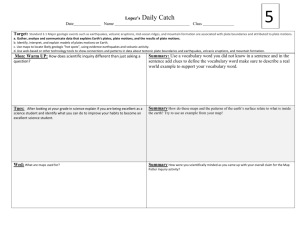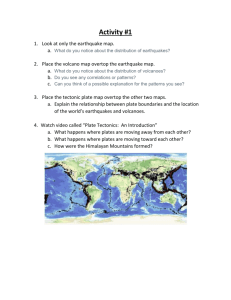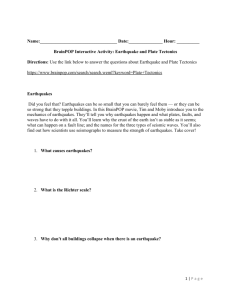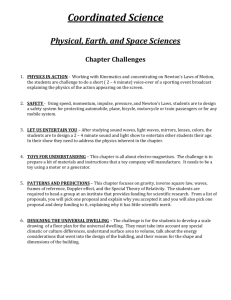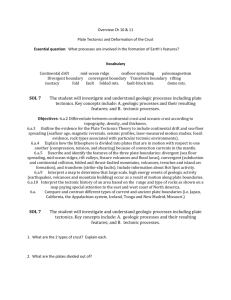standards in entire ic unit
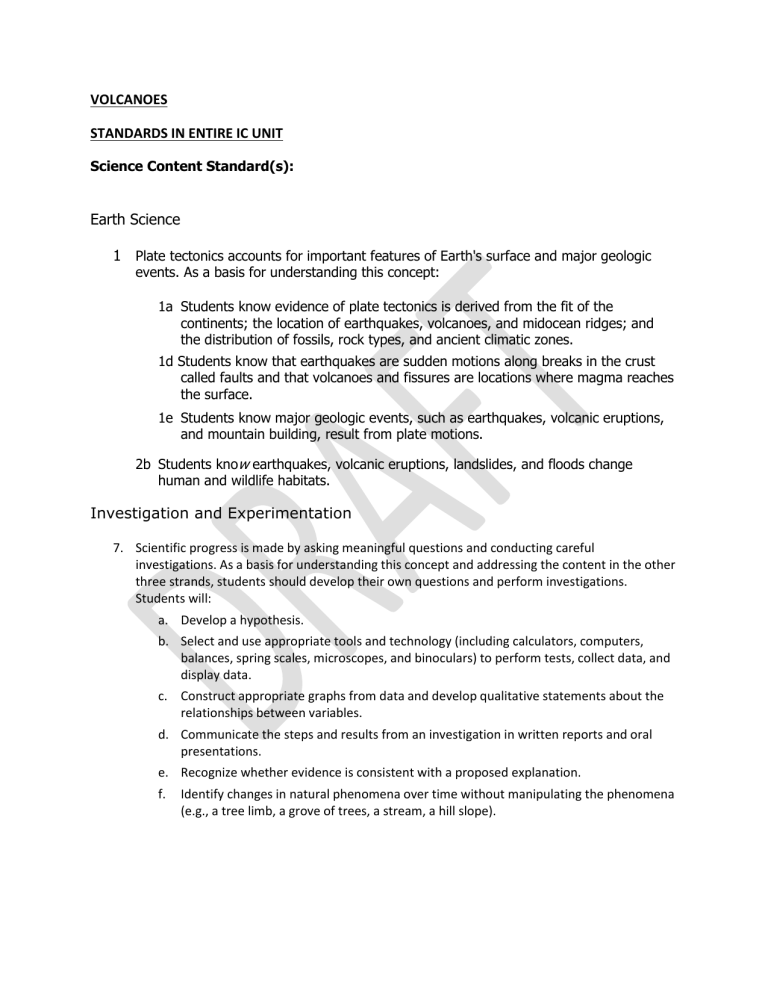
VOLCANOES
STANDARDS IN ENTIRE IC UNIT
Science Content Standard(s):
Earth Science
1
Plate tectonics accounts for important features of Earth's surface and major geologic events. As a basis for understanding this concept:
1a Students know evidence of plate tectonics is derived from the fit of the continents; the location of earthquakes, volcanoes, and midocean ridges; and the distribution of fossils, rock types, and ancient climatic zones.
1d Students know that earthquakes are sudden motions along breaks in the crust called faults and that volcanoes and fissures are locations where magma reaches the surface.
1e Students know major geologic events, such as earthquakes, volcanic eruptions, and mountain building, result from plate motions.
2b Students kno w earthquakes, volcanic eruptions, landslides, and floods change human and wildlife habitats.
Investigation and Experimentation
7.
Scientific progress is made by asking meaningful questions and conducting careful investigations. As a basis for understanding this concept and addressing the content in the other three strands, students should develop their own questions and perform investigations.
Students will: a.
Develop a hypothesis. b.
Select and use appropriate tools and technology (including calculators, computers, balances, spring scales, microscopes, and binoculars) to perform tests, collect data, and display data. c.
Construct appropriate graphs from data and develop qualitative statements about the relationships between variables. d.
Communicate the steps and results from an investigation in written reports and oral presentations. e.
Recognize whether evidence is consistent with a proposed explanation. f.
Identify changes in natural phenomena over time without manipulating the phenomena
(e.g., a tree limb, a grove of trees, a stream, a hill slope).
NGSS
MS-
ESS1-4.
MS-
ESS2-2.
MS-
ESS2-3.
Construct a scientific explanation based on evidence from rock strata for how the geologic time scale is used to organize Earth's 4.6-billion-year-old history. [Clarification
Statement: Emphasis is on how analyses of rock formations and the fossils they contain are used to establish relative ages of major events in Earth’s history. Examples of Earth’s major events could range from being very recent (such as the last Ice Age or the earliest fossils of homo sapiens) to very old (such as the formation of Earth or the earliest evidence of life).
Examples can include the formation of mountain chains and ocean basins, the evolution or extinction of particular living organisms, or significant volcanic eruptions.] [ Assessment
Boundary: Assessment does not include recalling the names of specific periods or epochs and events within them.
]
Construct an explanation based on evidence for how geoscience processes have changed Earth's surface at varying time and spatial scales. [Clarification Statement:
Emphas is is on how processes change Earth’s surface at time and spatial scales that can be large (such as slow plate motions or the uplift of large mountain ranges) or small (such as rapid landslides or microscopic geochemical reactions), and how many geoscience processes (such as earthquakes, volcanoes, and meteor impacts) usually behave gradually but are punctuated by catastrophic events. Examples of geoscience processes include surface weathering and deposition by the movements of water, ice, and wind. Emphasis is on geoscience processes that shape local geographic features, where appropriate.]
ESS2.A: Earth Materials and Systems
Earth’s systems, being dynamic and interacting, cause feedback effects that can increase or decrease the original changes. (HS-ESS2-1),(HS-ESS2-2)
Evidence from deep probes and seismic waves, reconstructions of historical changes in Earth’s surface and its magnetic field, and an understanding of physical and chemical processes lead to a model of Earth with a hot but solid inner core, a liquid outer core, a solid mantle and crust. Motions of the mantle and its plates occur primarily through thermal convection, which involves the cycling of matter due to the outward flow of energy fr om Earth’s interior and gravitational movement of denser materials toward the interior.
(HS-ESS2-3)
ESS2.B: Plate Tectonics and Large-Scale System Interactions
The radioactive decay of unstable isotopes continually generates new energy within Earth’s crust and mantle, providing the primary source of the heat that drives mantle convection. Plate tectonics can be viewed as the surface expression of mantle convection. (HS-ESS2-3)
Plate tectonics is the unifying theory that explains the past and current movements of the rocks at Earth’s surface and provides a framework for understanding its geologic history. Plate movements are responsible for most continental and ocean-floor features and for the distribution of most rocks and minerals within Earth’s
Analyze and interpret data on the distribution of fossils and rocks, continental shapes, and seafloor structures to provide evidence of the past plate motions. [Clarification
Statement: Examples of data include similarities of rock and fossil types on different continents, the shapes of the continents (including continental shelves), and the locations of ocean structures (such as ridges, fracture zones, and trenches).] [ Assessment Boundary:
Paleomagnetic anomalies in oceanic and continental crust are not assessed.
]
Crosscutting Concepts
Cause and Effect
Cause and effect relationships may be used to predict phenomena in natural or designed systems. (MS-ESS2-5)
Scale Proportion and Quantity
Time, space, and energy phenomena can be observed at various scales using models to study systems that are too large or too small. (MS-ESS2-2)
Systems and System Models
Models can be used to represent systems and their interactions
—such as inputs, processes and outputs—and energy, matter, and information flows within systems. (MS-ESS2-6)
Energy and Matter
Within a natural or designed system, the transfer of energy drives the motion and/or cycling of matter. (MS-ESS2-4)
Stability and Change
Explanations of stability and change in natural or designed systems can be constructed by examining the changes over time and processes at different scales, including the atomic scale. (MS-ESS2-1)
Science and Engineering Practices
Designing and Using Models
Analyzing and Interpreting Data
Constructing Explanations and Designing Solutions
CCSS that apply
Common Core State Standards Connections:
ELA/Literacy -
RST.6-8.1
RST.6-8.7
Cite specific textual evidence to support analysis of science and technical texts. (MS-ESS1-3),(MS-ESS1-
4)
Integrate quantitative or technical information expressed in words in a text with a version of that information expressed visually (e.g., in a flowchart, diagram, model, graph, or table). (MS-ESS1-3)
WHST.6-
8.2
SL.8.5
Write informative/explanatory texts to examine a topic and convey ideas, concepts, and information through the selection, organization, and analysis of relevant content. (MS-ESS1-4)
Include multimedia components and visual displays in presentations to clarify claims and findings and emphasize salient points. (MS-ESS1-1),(MS-ESS1-2)
Mathematics -
MP.2
MP.4
6.RP.A.1
7.RP.A.1
Reason abstractly and quantitatively. (MS-ESS1-3)
Model with mathematics. (MS-ESS1-1),(MS-ESS1-2)
Understand the concept of a ratio and use ratio language to describe a ratio relationship between two quantities. (MS-ESS1-1),(MS-ESS1-2) ,(MS-ESS1-3)
Recognize and represent proportional relationships between quantities. (MS-ESS1-1),(MS-ESS1-2) ,(MS-
ESS1-3)
